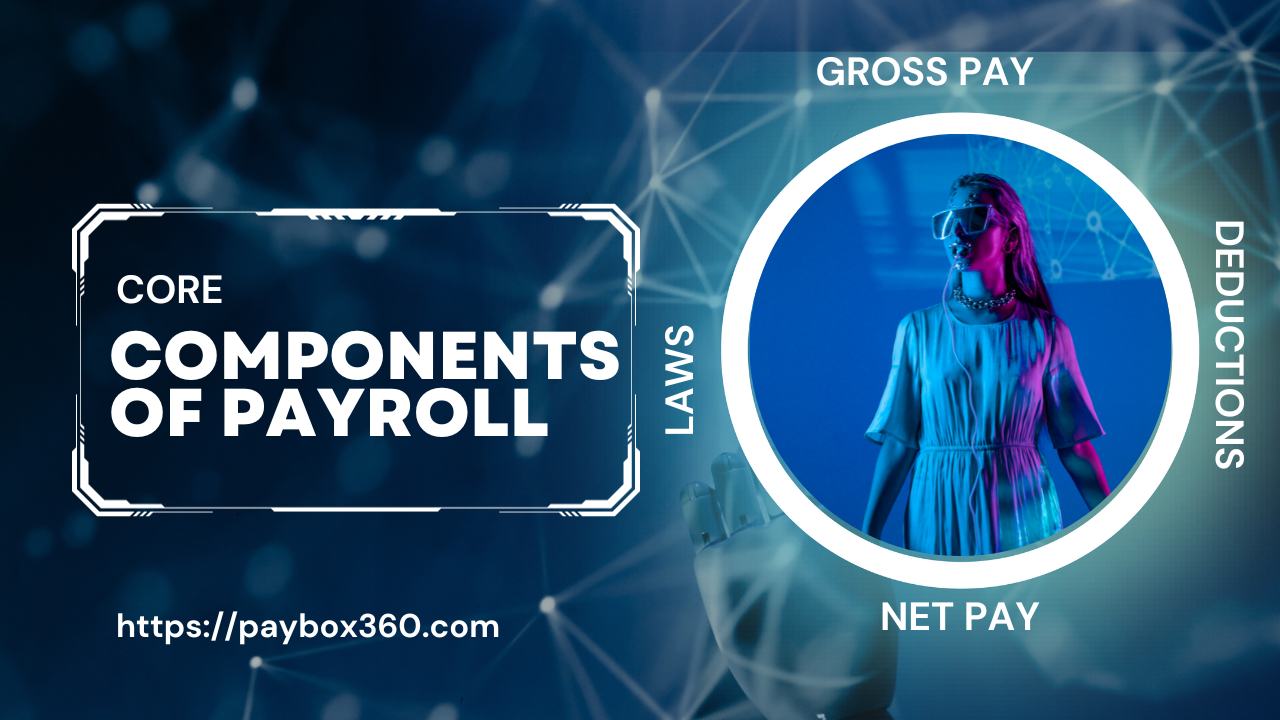Why is payroll processing difficult?
Payroll processing is hard because there are many rules and laws to follow, like taxes and how much people should get paid. If we make mistakes, people might not get the right amount of money, and that’s a big problem. So, we have to be very careful and do it the right way. It’s like doing homework with lots of rules and no mistakes allowed! But is payroll difficult to learn?
However, in this article, we will explore the complexities of payroll and discuss how modern solutions like Paybox360 can simplify the process.
The basics of payroll (simplified)
Payroll is the process of calculating and distributing wages to employees. It involves several components, such as wages, hours worked, benefits, tax deductions, and compliance with federal and state regulations. The complexity of payroll can vary depending on the size of the organization, budget constraints, and the available time.

Core component of payroll
- Calculating Gross Pay:
The first step in payroll is calculating the gross pay for each employee. This includes their salary, hourly wages, overtime, and any bonuses.
- Deductions:
Once you’ve calculated the gross pay, you need to account for deductions. This includes federal and state income taxes, Social Security, Medicare, and any other deductions specified by the employee, such as health insurance premiums.
- Net Pay:
After accounting for deductions, you arrive at the net pay, which is the amount an employee receives in their paycheck.
- Compliance with Laws:
Payroll requires compliance with various federal, state, and local laws. This includes ensuring proper tax withholdings and adhering to minimum wage laws, among other regulations.
- Record Keeping:
Keeping meticulous records of payroll transactions is essential. This includes maintaining records of employee hours, pay rates, and tax filings.
How can I learn to do payroll?
Now that we’ve established the fundamentals, let’s examine the learning curve associated with payroll.
1. Complexity Varies:
The complexity of payroll can vary significantly depending on the size of the business and its location. On the one hand, smaller businesses with fewer employees may have simpler payroll processes. On the other hand, larger enterprises with a global presence may face more intricate challenges.
2. Software Solutions for Payroll Management:
Technology has revolutionized payroll management. Additionally, many businesses use payroll software that simplifies calculations and ensures compliance. Learning to use software such as paybox360 can make the process less daunting.
3. Education and Training:
For those new to payroll, education and training are essential. Moreover, there are various online courses in payroll management and payroll certification programs that can help individuals gain a better understanding of payroll processes and laws.
4. Staying Current with Payroll Laws:
Payroll laws and regulations change over time. Therefore, to master payroll, you need to stay current with the latest updates. This may require ongoing education and keeping an eye on legislative changes.

Common Challenges in Payroll Management
While payroll can be learned, it’s not without its challenges. Here are some common challenges in payroll individuals may encounter when learning payroll:
The challenges in payroll are:
- Complexity of Taxation:
Tax laws can be complex, and navigating through them is often a challenge. Understanding federal, state, and local tax requirements is essential for accurate payroll processing.
- Compliance Issues:
Payroll professionals need to ensure their practices align with federal, state, and local laws. Mistakes can result in penalties and legal complications.
- Data Accuracy:
Payroll requires a high level of attention to detail. A small error in data entry can lead to significant payroll discrepancies, which can be problematic for employees and employers.
- Confidentiality:
Payroll data contains sensitive employee information, and maintaining confidentiality is crucial. Violations of privacy can have serious consequences.
Learning Resources for Mastering Payroll
To overcome the challenges and acquire proficiency in payroll management, there are several resources available:
- Online Courses in Payroll:
Many online platforms offer courses and certifications in payroll management. These can be a great way to learn at your own pace and develop expertise.
- Books and Publications on Payroll:
There are numerous books and publications on payroll management that can serve as valuable learning resources. Furthermore, these cover topics from basic principles to advanced strategies.
- Payroll Software Training:
As mentioned earlier, payroll software often includes training materials to help users understand the software’s features and compliance requirements. Additionally, these resources can be quite helpful for users.

Setting Up Payroll
Setting up payroll is a crucial step for any business. This process typically involves:
- Applying for a TIN:
Your organization will need a Taxpayer Identification Number (TIN) to file payroll taxes. Firstly, this number is obtained from the government and is essential for legal compliance.
- Obtaining Local or State Business IDs: Depending on your location, you may need local or state business identification numbers. Additionally, these are essential for income tax and unemployment tax purposes.
- Collecting Employee Documents: Your employees must complete necessary forms. In this way, these forms verify their identity and determine tax withholding.
- Choosing Pay Periods: Businesses have various options for pay periods, such as weekly, bi-weekly, semi-monthly, or monthly. Therefore, compliance with jurisdiction requirements is essential.
- Purchasing Workers’ Compensation Insurance: Some areas mandate workers’ compensation insurance, even for businesses with just one employee. Consequently, it’s crucial for businesses to be aware of these requirements.
- Offering Optional Benefits: Providing benefits like health insurance, retirement plans, and other perks can make your business more attractive to employees. Moreover, it can help you retain and attract talented individuals.
- Opening a Payroll Bank Account: Many businesses open a separate bank account specifically for payroll. Consequently, this makes it easier to track and manage transactions.
Doing Payroll on Your Own
Small businesses often start by doing payroll themselves, especially if they have only a few employees. However, it requires meticulous record-keeping and adherence to tax filing deadlines to avoid costly fines. The process includes:
- Calculating Hours Worked and Gross Pay: This involves tracking employee hours and determining their gross pay.
- Processing Payroll Deductions: Handling pre-tax and post-tax deductions, including federal and state income taxes, Social Security, Medicare, and other withholdings.
- Calculating Net Pay and Paying Employees: After deducting all necessary amounts, employees receive their net pay.
- Filing Tax Reports: Employers must file tax reports, such as Form 941 and Form 940, to comply with federal and state requirements.
- Documenting and Storing Payroll Records: Proper record-keeping is crucial to avoid compliance issues. This includes maintaining records for at least four years.
Using Professional Services for Payroll
As businesses grow, payroll management can become more challenging. Outsourcing payroll to professional service providers is a cost-effective option. These providers offer accuracy, compliance support, and data security. The process involves:
- Providing Tax Info and Documentation: Employers must supply all necessary payroll records to the service provider.
- Reporting Agent Authorization: The IRS requires notification when working with a payroll service provider.
- Processing Payroll: Payroll software automates the process, handling calculations, employee payments, and tax filings.
Benefits of Outsourcing Payroll
Outsourcing payroll has several advantages for businesses. First, it frees up time for other critical tasks and reduces the risk of costly errors. Additionally, payroll service providers offer convenience and expertise, ensuring accurate and timely payments.
Simplifying Payroll with PayBox360
In the modern business landscape, technology plays a significant role in simplifying payroll processes. Furthermore, Paybox360, a financial solutions platform, offers a range of tools to streamline payroll and other aspects of business management. Additionally, some key features of Paybox360 include:
Paybox360 simplifies payroll by automating various tasks, reducing manual labor, and ensuring compliance. Consequently, by adopting such a platform, businesses can save time and resources while avoiding costly mistakes in payroll management.
Conclusion
Is payroll difficult to learn? On the one hand, the answer depends on your perspective. On the other hand, while payroll can be complex and challenging, it’s also a skill that can be acquired with dedication and the right resources. First, understanding the basics, staying informed about regulations, and using technology to your advantage can all make the learning curve more manageable. Additionally, with the right tools and resources, it becomes manageable. Furthermore, businesses, especially small ones, can benefit from outsourcing payroll or using technology-driven solutions like Paybox360 to simplify the process. Consequently, payroll management is a critical part of running a business, and it’s essential to do it accurately and efficiently to avoid compliance issues and financial penalties.





